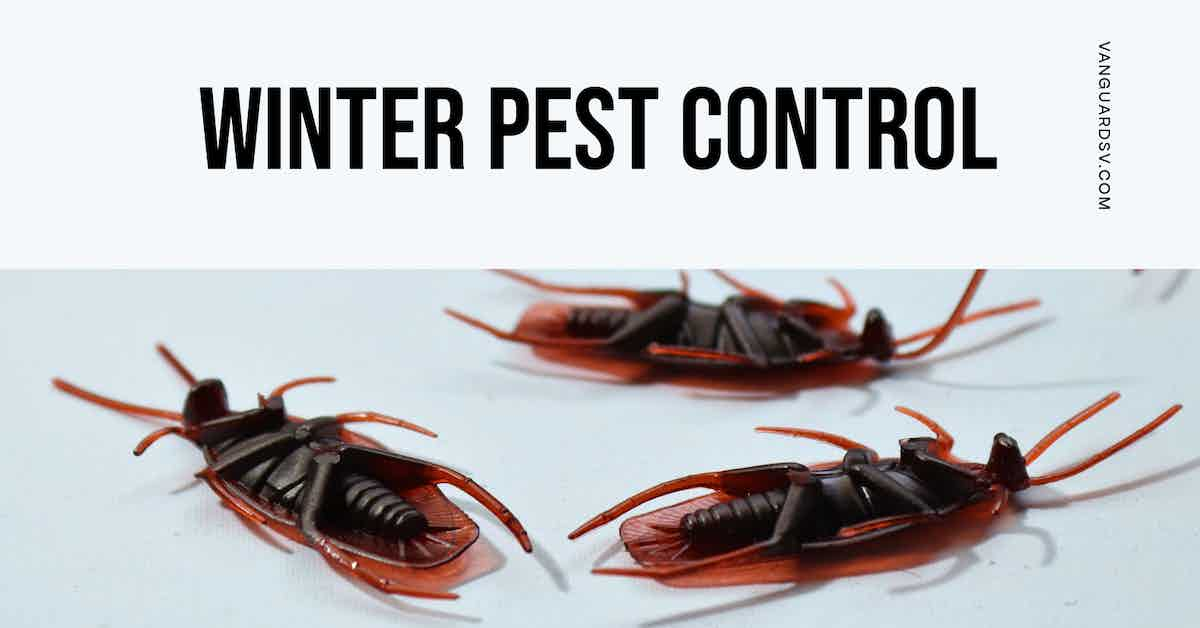During the long cold months of the winter, insects and other pests that typically live outdoors will seek shelter, warmth, food, and water inside homes, schools, and businesses, leaving a trail of costly damage and disease in their wake.

Why Do Outdoor Pests Come Inside During the Winter?
When the temperatures are warmer, most insects and other pests tend to remain outdoors, where food, shelter, and water are plentiful.
However, when temperatures head south for the winter, access to a steady food and water supply or warm and dry shelter becomes increasingly complex, and the compulsion to survive pushes many of these creatures toward ever-expanding human habitations.
Insects and rodents will seek breach points along the property in the form of cracks or pipes along the foundation, open windows and doors, and on packaging and material brought into the building by occupants.
Once inside, the insects and rodents will treat your building as though it were an outdoor, naturally occurring resource by:
- Tearing up insulation and other building materials to build a nest.
- Defecating and urinating on floors or in walls, ceilings, and air ducts.
- Breeding and giving birth.
- Seeking and consuming whatever food and water are available.
- Sometimes hunting, killing, and consuming other pests indoors, and;
- Spreading disease.
In the U.S., the most common pests to plague classrooms and businesses during the winter tend to be:
- Cockroaches.
- Rodents.
- Spiders.
- Fleas, and;
- Bedbugs.
The Bottom Line Between Bugs and Businesses
Pest infestations impact most U.S. businesses, with costs soaring into the tens of billions of dollars annually.
According to a 2016 article published by the International Facilities Management Association;
A recent report, commissioned by the Centre for Economics and Business Research (Cebr) found that U.S. businesses incurred an increase of US$6.8 billion in their operating costs in 2014 as a direct result of pest infestations in their facilities.
They also experienced US$13.2 billion in lost revenue.
Additionally, the report found that 90% of businesses surveyed reported at least one infestation in the last five years, with a new infestation occurring roughly every twenty months.
Survey respondents were most concerned with the following:
- 66% - A loss to the business's reputation and;
- 65% - Financial penalties and fines.
Additionally:
- 42% of respondents stated they lost at least one working day due to a pest infestation.
- 26% said they lost at least five working days, and;
- 36% of respondents reported experiencing a "detrimental impact on morale."
Source:
Prevention Methods
Prevent pest and rodent infestations requires:
- Sealing all breach points, including broken screens and cracks in the building's foundation.
- Removing anything that attracts pests and rodents, especially food waste and packing materials, as far from the building as possible.
- Cleaning regularly to remove food, standing water, and other attractants inside the facility.
- Inspecting for, reporting on, and removing pest and rodent nests immediately, and;
- Maintaining the adjacent grounds and parking lot as a buffer against pests and rodents by maintaining a clean and professional appearance where pests cannot hide behind or under garbage or overgrown landscaping.
The Dangers of Chemical Pesticides and Rodenticides
Commercial and consumer-grade pesticides and rodenticides are deadly--not just for the pests but for children and pets as well.
According to the National Pest Information Center;
All rodenticides can be toxic to mammals and birds when eaten.
Most rodenticides are also toxic when breathed in or touched.
People, pets, and wildlife can suffer from serious health effects after exposure to just a single dose of rodenticide.
Rodenticides are formulated as baits, which have ingredients that attract animals.
For example, baits might contain peanut butter, molasses, or grains.
These ingredients can be also attractive to children and pets.
The solution?
Integrated pest management and control services combined with daily enhanced cleaning protocols that discourage infestations by depriving pests and rodents of food, water, and shelter.
Takeaway
This winter, pests and rodents will make their way into schools and businesses, where they will proceed to:
- Cause tens of billions of dollars to the built environment.
- Reduce occupant morale, resulting in diminished productivity and output quality, and;
- Cause short and long-term health issues, further diminishing occupant morale and productivity and likely resulting in costly litigation.
Integrating pest management and control services into your facility's custodial protocols will allow for the development of safer, prevention-focused alternatives to toxic chemical treatments.
However, onboarding and managing the requisite labor and material resources necessary to ensure the highest standards of cleanliness are achieved and maintained may prove cost-prohibitive for many organizations.
Outsourcing is a proven method for onboarding highly in-demand cleaning and disinfection services and experience for a fraction of the price of maintaining a similar service in-house.
If you would like more information regarding the effectiveness of high-performance infection prevention and control measures, or if you would like to schedule a free, no-obligation on-site assessment of your facility's custodial needs, contact us today for a free quote!
In Bakersfield, CA, call (661) 437-3253
In Fresno, CA, call (559) 206-1059
In Valencia, CA, or Santa Clarita, CA, call (661) 437-3253
In Palmdale, CA, or Lancaster, CA, call (661) 371-4756

